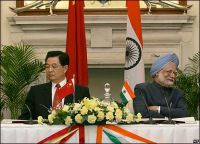
India and China are having big potential in their bilateral trade. It is expected that both of them will lead the world economy in the coming decades. They are the fastest growing and they belong to the top 4 biggest economies of the world. China and India are the largest populated countries as well.
Perhaps, the most important aspect from the trade point is that both countries share boundaries and this means that the scope for cross border trade is bigger. Justifying to these positive factors, India- China trade is growing at a high pace. Trade between the two has reached a figure of US $75 billion in 2011. In bilateral trade, China is enjoying a trade deficit of around $28 billion.
The big and widening trade deficit is a matter of concern for India. Simultaneously, nature of tradable commodities is also not giving any hope for her. This is because, India’s export to China largely comprises of iron ore and other mineral products. On the other hand, India’s imports from China are mainly machineries or capital goods.
Over the last few years, India has tried many measures to improve her bilateral trade position. One of them was imposing an export tax of 30% on the export of iron ores. Depleting reserves, increasing environmental constraints and the need to satisfy future domestic demand etc, compelled New Delhi to take such a measure.
But, the most important concern for India is on the machinery import front. This group constitutes the second largest import item for India after crude oil imports. If crude imports are around 30% of the total imports, capital goods amount to nearly 22%. Over the last few years, China has emerged as the cheapest source of machineries for India replacing the western countries.
Chinese machinery exports are especially concentrated towards the telecom, power and fertilizer sectors. The domestic corporate sector is used to the import and use of cheap Chinese machineries.
Increasing imports of machinery from China has created many problems for the domestic economy. Firstly, imports from China are lost opportunity for Indian machinery firms like BHEL. Besides, it weakens the country’s balance of payment position. In the wake of expansion of capacity addition in the power sector and other infrastructure expenditure, machinery imports from China may increase in the coming years. To mitigate the adverse trend, the government in the budget 2012-13 may put additional duty on imports of machineries.
It is because of India’s weaknesses rather than China’s fault that machinery imports are surging into the economy. The country should concentrate on developing quality machineries for the domestic economy. Other measures like import tax is not long lasting to counter capital goods imports.










